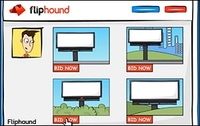Commentary
Fliphound Brings Manual Real-Time Bidding To DOOH
- by Tyler Loechner , Staff Writer @mp_tyler, June 19, 2014
 Automation and “real-time”
marketing are seeping into every corner of the ad market, from online display all the way to TV and out-of-home.
Automation and “real-time”
marketing are seeping into every corner of the ad market, from online display all the way to TV and out-of-home.
Fliphound, a Wichita, KS.-based software provider for digital-out-of-home (DOOH) advertisers, was founded just under one year ago to allow digital billboard owners to sell their outdoor inventory online. Anywhere between 70-80% of digital billboards are filled up, and Fliphound wanted to help owners sell the other 20-30%.
That same issue -- a need to monetize remnant inventory -- is what gave rise to real-time bidding (RTB) in online display advertising.
The company started selling advertising space for operators and has seen its business model evolve into a more complete online marketplace, according to CEO Doug Robertson. But while Fliphound is expanding, we aren't talking about major scale quite yet -- its software is currently used on just 21 billboards across the country. According to a real-time "ads served" counter on the company's Website, just over 27.3 million have been served to date.
Each Fliphound board supports eight ad slots. If four of those slots are reserved via direct deals, the remaining four are put into the Fliphound “exchange.” The company doesn’t operate a real-time bidding system the same way online ad exchanges do, but it’s similar.
Advertisers choose a billboard they want to advertise on and set a bid price and frequency request, explained Lacey Roe, a sales associate at Fliphound. If they outbid the competition, their ad gets displayed on the billboard during its next cycle, and all subsequent cycles, until the advertiser run out of funds, is outbid, or manually cancels the campaign.
Robertson said Fliphound is seeing medium and smaller agencies use the software to augment existing marketing campaigns with outdoor. In an earlier statement, Robertson said over 80% of Fliphound's customers are new to the outdoor billboard advertising market.
The draw? There are no contract requirements, making the service attractive for advertisers looking to test the waters (though Fliphound can also be used on a contract basis to run guaranteed campaigns). Roe said the typical cost per message or ad is between four and 10 cents.
The model is intriguing because of how similar its origins are to online display RTB. Yes, there are vast differences -- not the least of which is a difference in scale and inability to target individual consumers -- but Fliphound is yet another example of how ad technology is being used to flip traditional trade models into something more efficient.



